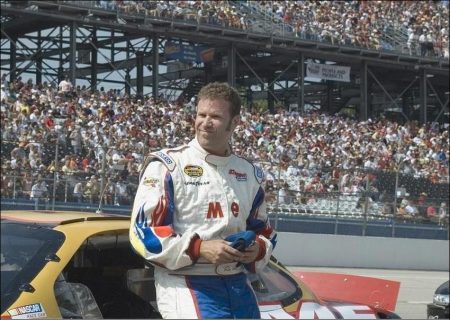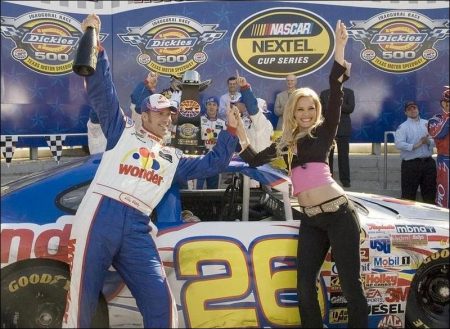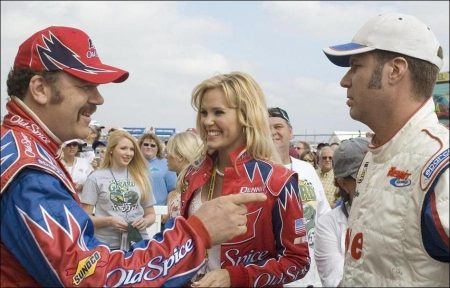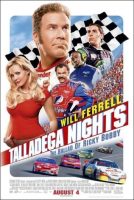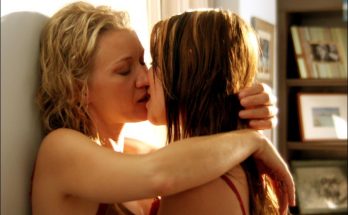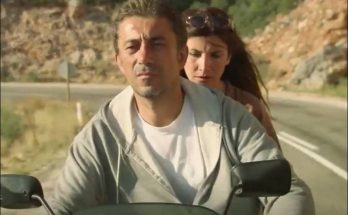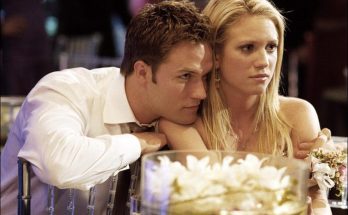Tagline: The story of a man who could only count to #1.
Talladega Nights tells the story of NASCAR stock car racing sensation Ricky Bobby (Will Ferrell) whose “win at all costs” approach has made him a national hero. He and his loyal racing partner, childhood friend Cal Naughton Jr. (John C. Reilly), are a fearless duo — dubbed “Thunder” and “Lightning” by their fans for their ability to finish so many races in the #1 and #2 positions, with Cal always in second place. When a flamboyant French Formula One driver, Jean Girard (Sacha Baron Cohen), challenges the “Thunder” and “Lightning” for the supremacy of NASCAR, Ricky Bobby must face his own demons and fight Girard for the right to be known as racing’s top driver.
Synopsis
Ricky Bobby (Will Ferrell) has always dreamed of driving fast — real fast — like his father, Reese Bobby (Gary Cole), who left the family to pursue his racing dreams. Early on, Ricky’s mother, Lucy Bobby (Jane Lynch) worried that her boy was also destined to end up as a professional daredevil on wheels. Ricky Bobby first enters the racing arena as a “jackman” for slovenly driver Terry Cheveaux (Adam McKay) and accidentally gets his big break behind the wheel when Cheveaux makes an unscheduled pit stop during a race to gorge on a chicken sandwich. Ricky jumps into the car and … so begins the ballad of Ricky Bobby.
Ricky quickly becomes one of NASCAR’s top stars, supported by his pit boys — the impressively large crew chief Lucius Washington (Michael Clarke Duncan), a trio of lovably moronic but loyal crew members, Herschell (David Koechner), Kyle (Ian Roberts) and Glenn (Jack McBrayer), as well as racing partner and boyhood best friend, Cal Naughton, Jr. (John C. Reilly). They are all part of the Dennit Racing team, headed by wealthy Dennit Senior (Pat Hingle) and his petulant son, Dennit Junior (Greg Germann), whose jealousy of Ricky Bobby increases with every victory.
In a short time, Ricky Bobby is on top of the world. He has everything a championship NASCAR driver could ever want — a gorgeous wife, Carley (Leslie Bibb), a lakeside mansion, two hell-raising sons, Walker (Houston Tumlin) and Texas Ranger (Grayson Russell), huge sponsor endorsements and a string of victories from Daytona to Darlington.
Ricky Bobby’s “win at all costs” approach has made him a national hero. But as he quickly realizes, in racing, as in life, you have to watch out for the curves. After a frightening crash sends Ricky Bobby to the hospital, he loses his nerve and falls on hard times. When his career and his wife are taken over by his friend Cal, Ricky Bobby turns his back on racing and takes his sons back to his small hometown to live with his mother.
But Ricky just isn’t cut out for the slow life away from the race track and soon hits rock bottom. His mother reluctantly turns to the only person she can think of to help her son — his estranged father Reese Bobby. His old man still has a few old racing tricks to help Ricky conquer his fear of driving. Ricky Bobby will do anything to find a way back to the top, no matter how many speed bumps life throws his way.
About the Production
The idea for Talladega Nights: The Ballad of Ricky Bobby was the brainchild of co-writers Will Ferrell & Adam McKay, who have been writing partners since meeting on the set of “Saturday Night Live” — where Ferrell was a fledgling cast member and McKay a show writer — nearly a decade ago. Their collaboration continued after they left the show, most recently on the outrageous send-up of 1970s newscasters, Anchorman: The Legend of Ron Burgundy (produced by Judd Apatow, who also produced Talladega Nights).
A comedy about NASCAR had been racing around their minds for several years. “Will and I talked about NASCAR racing while he was making Elf,” McKay recalls. “We were in New York City and he was set to take a break before we started work on Anchorman. We noticed how fascinating the world of NASCAR racing had become. It’s gigantic. We weren’t even huge NASCAR fans at the time, but after we started going to the track, we got swept up in the phenomenon.”
It was Talladega Nights producer, Jimmy Miller, who first invited them to join him at a NASCAR race in Fontana, California, where they experienced the heady sights, smells and sounds of a NASCAR event.
“As soon as we heard the roar of the engines, we knew there was something here to make a movie about,” says McKay. “The crowd was huge — like a city, with campers and bonfires outside of every race. I was told that during the Talladega Race [the UAW-Ford 500 at the Talladega Superspeedway] each year, the speedway becomes the second largest city in Alabama.”
Ferrell is a longtime sports fan and studied sports information for his degree from the University of Southern California before choosing acting as his career. Although he was previously aware of stock car racing, he had never been to a race before that fateful day in Fontana.
“I knew a fair amount about NASCAR just because it had grown in popularity,” says Ferrell. “I knew some of the top drivers and had a fairly good working knowledge of the sport. But I never understood the intensity of it all until we started writing the character of Ricky Bobby. The challenge for us became writing a movie that was both a comedy and a racing film, because we really wanted the audience to experience the amazing visceral reaction we had had while watching these cars fly around the track at 200 miles per hour.”
The character of Ricky Bobby owes a great deal to classic sports films. “Ricky is a typical sports movie character,” Ferrell claims. “He came from simple beginnings and, as a boy, enjoyed the need for speed. His motto became ‘If you ain’t first, you’re last’ — something his daddy taught him early in life. That meant either winning or wrecking, a go-for-broke attitude that eventually would lead to his downfall.”
“As soon as Will came up with the voice for Ricky, I was hooked,” says McKay. “I told him then that it looked like our lives for the next two years would be dealing with race cars.”
Ferrell and McKay continued attending NASCAR events and became friendly with the drivers such as Dale Earnhardt, Jr. and Jimmie Johnson. As the project began to take shape, the participation of the NASCAR organization became a reality, enabling the filmmakers the possibility of filming in the pits and garages of some of America’s most popular racing arenas. “We were very lucky to get NASCAR involved in the movie,” says producer Judd Apatow.
“We showed them the script early and hoped they would come onboard. If they didn’t, we would have to come up with a new racing league. But they got it and we were excited that NASCAR could have a sense of humor about it and really allowed us to be a part of their world. During filming, occasionally some guy at NASCAR would pitch us a better joke than we had, and then we were embarrassed that they could ride cars at 150 miles per hour and be funnier than us.
NASCAR executives Richard Glover and Sarah Nettinga became closely involved with the film and monitored the accuracy of its design and content, as well as facilitating access for the production crew to actual racing events. Production designer Clayton Hartley, who had also worked on Anchorman: The Legend of Ron Burgundy, joined with costume designer Susan Matheson to ensure the sets, cars and uniforms (called “fire suits”) were in keeping with real NASCAR drivers and events.
“NASCAR approved our sponsors of our fictional drivers’ cars,” says Clayton Hartley, who previously provided the production design for such films as American Wedding and Kicking & Screaming, “which included Terry Cheveau’s fictional 1996 Laughing Clown Malt liquor stock car, as well as Ricky Bobby’s contemporary #26 Wonder Bread/POWERade stock car, Cal Naughton, Jr.’s #47 Old Spice stock car and Jean Girard’s #55 Perrier stock car. We also knew that we had to come up with designs for all of the cars and purchase the cars themselves. We hired NASCAR designer Sam Bass to help us refine our look and keep it real.”
Stunt coordinator Andy Gill, who had just worked with NASCAR on Herbie: Fully Loaded, was prepared to work closely with NASCAR to achieve the realism needed for the exciting races in Talladega Nights, as well as the breathtaking collisions called for in the script.
“I had worked in the NASCAR world and understood the high level of their involvement,” says Gill, who previously served as stunt coordinator on such films as Bad Boys™ II and Pearl Harbor. “They get very involved in every aspect of the film. You just can’t throw any car in there and expect it to be okay. It has to have the right look for the right model year. All the designs and sponsor decals have to be in the right places. That kind of coordination would have otherwise been impossible since we were working with 35 cars and wrecking them all the time.”
With NASCAR on board, producers Apatow and Miller and executive producer David Householter were able to secure the film’s locations and cast. Charlotte, North Carolina, with its majestic Lowe’s Motor Speedway, was chosen as the film’s main location, with the actual Talladega Superspeedway in Alabama slated as well.
“The footage you pick up at a real race can’t be created any other way,” says Gill. “You’ve got the cars, the motor homes, the support vehicles. You have everything in the racetrack arena there waiting for you. And when the crowds arrive, it all springs to life. You could never afford to recreate that on your own.”
Authentic locations locked in, the filmmakers now turned their attention to bringing together a strong comedy cast. As on Anchorman, director McKay and star Ferrell planned to shoot as many improvisational variations on their scripted scenes as time would allow. “In a typical film comedy, you may do a scene as written 90 percent of the time,” explains Ferrell. “And you might do a take or two for fun off script. In our films, we pretty much do one take that is from the script and take off from there. A lot of actors aren’t used to working in that style and sometimes view improvisation as a burden. But once everyone gets into the flow of it, it becomes a really fun process.”
With that in mind, several of the actors chosen for the film had a background in improvisation. Performers like Jane Lynch, Ian Roberts and Jack McBrayer had done improvisational work for Chicago’s Second City. Others, like Gary Cole and Michael Clarke Duncan, had also trained on the Chicago stage.
Sacha Baron Cohen, who plays the flamboyant French driver Jean Girard, was also no stranger to improv, it being the core of his popular HBO television series “Da Ali G Show.”
“I think how Adam and Will work is brilliant,” says Baron Cohen. “Will is such an amazing improviser. He has the ability to take any scene in a totally different direction. He’s so earnest and always so in character that it is incredibly easy to improvise with him.”
Two actors who were surprisingly very talented at improvisation were Oscar nominee (for Chicago) John C. Reilly and former model Leslie Bibb, a current regular on the popular television series “Crossing Jordan.”
“We had actually offered John a part in Anchorman, but he couldn’t take it because he had committed to working with Martin Scorsese on The Aviator,” recalls McKay. “He was so funny, he blew us away. So when we wrote this film, we knew we had to find a role for him. He is incredible, a revelation. We were amazed at how well he did with improvisation.”
Bibb also took to the loose improv climate on set. Although she had done several films, this was the first that enabled her to showcase her flair for comedy. “Leslie did so well improvising with Will, we immediately knew she was right for the part,” says McKay. “But the character of Carley Bobby is a blonde bombshell, and when Leslie read for us she was dressed down and a short haircut. Once we saw her in all of her blonde glory, with the sunglasses and the tight jeans, we were shocked at her transformation. She possesses that rare combination of talents, an actress with movie star looks who can create a strong character and flow right along with all the improv around her. She is terrific.”
Unlike many of her co-stars, Bibb actually had a connection to NASCAR racing that dates back to her Virginia childhood. “When I was a kid, we went to the Daytona 500 in Florida,” she says. “I remember my Mom getting a picture of herself with [former NASCAR champion] Richard Petty. I was dazzled by Richard and his blue car from then on. I became a pretty big racing fan after I got the part in this movie, though. Now I know all the drivers’ names and their cars. Getting to work in the actual pits and garages was truly exciting and dangerous at the same time.”
Preparation to film the movie required Ferrell, Reilly and Baron Cohen to learn the driving fundamentals for sleek stock cars that are capable of reaching speeds of almost 200 miles per hour on the track. Along with director McKay, the trio enrolled in a (hopefully) no-crash course at Lowe’s Motor Speedway to learn how to race a car on the track. With instructors from the Richard Petty Driving Experience, these Hollywood novices quickly found themselves behind the wheel of a powerful NASCAR race car.
“The first thing they do is have you ride shotgun with a real NASCAR driver at about 180 miles an hour around the track. It was one of the most unpleasant experiences of my life,” admits Baron Cohen.
After the ride along, the actors were then required to get behind the wheel themselves. “We did about eight or nine laps following a pace car,” says Ferrell.
“They taught us how to take a line on the track, how to approach curves. I think I was going about 135 miles an hour. You kinda’ get hooked right away.” It was Reilly, however, who ultimately won the right to be called “the world’s fastest actor,” according to Ferrell. “I think John got up to 143 miles an hour. Throughout, the three of us had only one goal: to beat Britney Spears, who had once gone 112 miles an hour. Fortunately, we all did.”
McKay came away with new found respect for the NASCAR drivers after his experience on the speedway. “As soon as we heard those engines roar, we all turned into terrified chickens,” he laughs. “When we got to drive, though it was exhilarating taking the curves and banking at a 45 degree angle. It was like climbing a wall — truly insane, because they tell you to accelerate into the bank, but your natural instinct is to slow down. The experience really came in handy when it actually came time to suit up and film the actual scenes on the track, as well as in the garages and the pits.”
The production’s pit crew consisted of Michael Clarke Duncan, David Koechner, Ian Roberts and Jack McBrayer, who attended “pit school” to learn how to jack up cars, change tires and refuel racecars in record time. Ferrell also joined in, to master the trade of “jackman,” the person responsible for jacking the car up for wheel changes.
“As pit crew chief, all I had to learn was how to tell the other guys what to do,” says Duncan, who plays the imposing Lucius Washington. “I was in my shorts and tank-top ordering them around, because it’s my job. Those guys were in a constant sweat for two hours since the tires weigh about 75 pounds. The real NASCAR pit crews are athletes — football and baseball players — recruited especially for their athletic ability.”
After a few hours of grueling study, the actors were able to actually get their pit stop time down to a remarkably fast 22 seconds. “Real NASCAR crews can do it in 13 seconds,” admits Roberts, who plays pit crew member Kyle. “Even though we got it down to 22 seconds, in the real NASCAR world, that long of a pit stop would probably cost us the race.”
“I was actually impressed that we got our pit stop time down to 22 seconds,” says Ferrell. “Some of the drivers told me that 22 seconds might be OK for a lower race division such as the Busch series or ARCA races, so in a way, we were actually competitive. Now I have something to fall back on if this whole film acting thing goes away,” he muses.
NASCAR went to great lengths to grant the production full access to the inner workings of their speedways and ensure their safety as well. Everyone was required to wear protective ear devices and taught to be attentive to fast-moving cars and other dangers that can occur at the racetrack. Many of the scenes at Lowe’s Speedway and Talladega Superspeedway required patience because the production was granted space to gather in a vacated pit only when a particular team had wrecked a car or blown an engine and had been eliminated from the competition.
“We had a great deal of help from NASCAR,” says McKay. “They were completely open and gracious to us from start to finish. We also won over the team owners and drivers. Without them, we could never have secured the access we did. Still, it was tough to shoot at the actual races, because we had to wait to use a garage or a pit. And when they came available, we immediately had to man the battle stations to get everyone ready to film on a moment’s notice.”
The film’s pit crew worked in the actual pits during races at both Lowe’s and Talladega and shot extensively in the working garages. Although much of the dialogue was looped in later due to the thunderous noise all around, these scenes enabled the filmmakers to capture the real urgency of an actual NASCAR event.
During filming at the speedways, the production mingled with real NASCAR crews and drivers, some of whom wound up with small roles in the film. “Many of the drivers came up to say hello,” says Ferrell. “And they often asked to be in the film. We met real mechanics and pit crews, who were very accommodating the entire time we were on their turf. They actually shut off their engines for us sometimes so we could get a take. They were extremely gracious and generous.”
“NASCAR drivers do a lot of television interviews and commercials,” says McKay. “So they are relaxed and totally natural. Dale Earnhardt, Jr. has a moment in the film, as does Jamie McMurray. Dale was surprisingly funny, too. He has great comic timing. I was impressed.”
Filming at the 2005 UAW-GM Quality 500 at the Lowe’s Motor Speedway presented new challenges since it takes place at night. Extra precautions were required in the garage areas and pits during the race, and cast and crew had to be on the lookout for cars rumbling in from the track at any moment.
Perhaps the most affecting true-to-life moment for the actors came when Ferrell, Baron Cohen and Reilly were introduced as their characters to the Talladega crowd of 200,000 screaming fans. When Ricky Bobby and Cal Naughton, Jr. were announced, the crowd went wild. But when Frenchman Jean Girard hit the stage, there was a collective — and deafening — boo.
“Adam said he was worried that I would get depressed after the whole stadium booed me,” says Baron Cohen. “I wasn’t surprised. It reminded me of the last time I went to Alabama, when I was playing a gay Austrian character for my show and was booed by 90,000 drunken men at the Alabama-Mississippi football game. The only way I got out alive was by switching clothes with the sound man.”
Prior to production, McKay and his producers considered avoiding shooting during real races, but access to large cheering crowds and the overall ambience of the races made it impossible to resist taking the chance to capture the immediacy and excitement of NASCAR events.
“Our executive producer, David Householter, convinced us that we had to give it a try,” recalls McKay. “He believed that you couldn’t beat the production value of filming during an actual live race. There is no substitute for a track crammed with 200,000 screaming fans. It gives the film a feel that is impossible to fake. In terms of feasibility, it was absurd to have our crazy characters performing in the midst of all this real action. But we never missed a single shot. We got everything we needed during those races.”
Director of photography Oliver Wood, who has shot such fast-paced action films as The Bourne Identity and Fantastic Four, collaborated closely with McKay to capture the reality of the races. “Oliver is the best there is when it comes to shooting action,” McKay attests. “He believes that each movie should be shot the way it needs to be shot. He sold me on using handheld, a rarity in comedy films.
But he was right. It added energy to the shots and actually helped the comedy. Because the races look so real, you care more about what happens to the characters. The angles and cameras we came up with for the wrecks and stunts were unbelievable. It gave the movie a ‘big picture’ feel — which is exactly what we wanted, because if you don’t believe the racing, you won’t believe anything else about the story either.”
Although the actors are shown behind the wheels of their cars, they did very little actual driving. Trained stunt men were responsible for most of the driving, which averaged 180 miles per hour. The races were filmed at Lowe’s, Talladega and an older NASCAR track, the North Carolina Speedway (The Rock) in Rockingham, North Carolina, which is located about an hour east of Charlotte and was a famous racing destination in the earlier days of NASCAR.
“I loved shooting at Rockingham because it was one of the legendary Southern tracks,” says Ferrell. “It’s also the site of one of my most dangerous scenes when Ricky returns to racing after his debilitating wreck. He is so scared he can only get up to 25 miles per hour. All the other drivers just whiz past him. For the shot, I was actually being towed while the other cars passed me at 150 miles an hour.”
Another risky proposition for Ferrell’s Ricky was a scene when his father, Reese (Gary Cole), decides to help his son conquer his fear of driving by putting a live cougar in the car with him. Fortunately, the cats they used, Dylan and his sister Kasey, were total pros trained by Steve Berens and his company Animals of Distinction.
“The scene with the cougar in the car was one of my favorites,” McKay admits. “The real cats turned out to be sweet and very demure, so it was hard to make them look menacing. You wanted them to snarl and growl, but they were like kitties. Still, as soon as they were let out of their cage to walk to the set, the whole crew froze in fear. So, I guess I’d take a happy cougar over an angry cougar any day.”
For Ferrell, one of the most daunting aspects of the production wasn’t having to act with a live mountain lion, but suiting up every day in his thick driver’s uniform, which is called a fire suit. “It is kind of like wearing a moving blanket,” he says, “and just as hot. But they are beautiful pieces of clothing. Maybe they’ll be the next fashion thing — fire retardant clothing.”
The film was shot in and around Charlotte, North Carolina, using hundreds of locals as extras and crew members. Communities such as Gastonia and Cramerton stood in for Ricky Bobby’s boyhood fictitious boyhood hometown of West River, North Carolina. Girard’s sprawling estate was located in the heart of Charlotte and Ricky’s mansion was situated on a lake near Cornelius.
To bolster the authenticity of the film, real NASCAR sportscasters and announcers were used, including analysts Darrell Waltrip, Larry McReynolds, Mike Joy, Benny Parsons, Bill Weber, Wally Dallenbach, Bob Jenkins and Dick Berggren. With the help of NASCAR, the filmmakers were able to pack in the power and excitement of the real thing.
“The racing stuff is fantastic,” says McKay, “and in addition you have this absurdist comedy with great comic actors like Will, John, Sacha and Jane Lynch, as well as such world-class performers as Michael Clarke Duncan, Gary Cole, Amy Adams and Leslie Bibb. We have a lot going for us and I think it’ll be entertaining to a wide audience.”
After the experience of shooting NASCAR races, many of the cast and crew became immediate and big fans of stock car racing. “I watch all the races now on Sunday,” says McKay. “I know all the drivers and their cars. I think that once you’ve experienced the spectacle of NASCAR racing, with all of its strategy and mechanics, you can’t help but become a fan. There is a part of me that will always be hooked.”
Talladega Nights: The Ballad of Ricky Bobby (2006)
Directed by: Adam McKay
Starring: Will Ferrell, John C. Reilly, Sascha Baron Cohen, Gary Cole, Michael Clarke Duncan, Leslie Bibb, Jane Lynch, Amy Adams, Molly Shannon, Andy Richter, David Koechner
Screenplay by: Will Ferrell, Adam McKay
Production Design by: Clayton Hartley
Cinematography by: Oliver Wood
Film Editing by: Brent White
Costume Design by: Susan Matheson
Set Decoration by: Casey Hallenbeck, Richard Karpinski, Sean Keenan, Richard Krish, William Lindsay
Art Direction by: Virginia L. Randolph
Music by: Alex Wurman
MPAA Rating: PG-13 for crude and sexual humor, language, drug references and brief comic violence.
Distributed by: Columbia Pictures
Release Date: August 4, 2006
Views: 107
